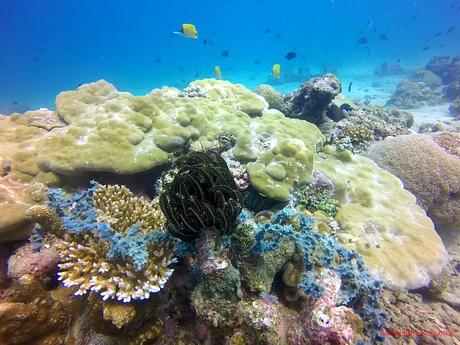
There is a land so alien, mysterious, and dangerous that we barely know anything about it. Yet, this place is very near us; it starts where the green plains end and the azure sea begins. Yes, we are talking about the beautiful, colorful empire beneath the waves, a kingdom of vast coral reefs, biological wonders, and strange geological formations. In the Philippines, we are thankful to have a large share of that empire. A part of that natural treasure happens to be situated just 3 hours away from Manila in the sleepy dive resort town of Anilao, Batangas.
From our previous blog posts, you know how excited we can get if we get the chance to explore our country’s magnificent dive spots. So, together with our friends Loraine and May, we jumped at the opportunity to dive in Anilao, one of the most popular and highly diverse dive sites in the country.
We departed from Kapusod Tree House before sunrise to catch “connecting” trips to Mabini, Batangas. Before proceeding to the popular dive town of Anilao, we had a hot and delicious breakfast of eggs and (lugaw) porridge; it’s a hot meal that is less than 50 per person!
After breakfast, we hailed a tricycle to take us to Anilao. After almost an hour of a butt-slipping ride, we finally arrived at our dive provider.
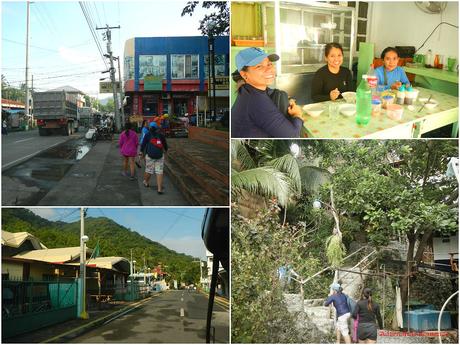
Our dive service provider is a popular and unique establishment called Bontoc in Batangas Bed and Breakfast (BBBB). Its tongue-twister name comes from the idea of bringing in snippets of the local culture in the cool highlands of Bontoc to the warm shores of Anilao.
As you can see from the photo below, the bed-and-breakfast’s architecture is not the usual fare. The use of whole wood and logs are more prevalent in the forested areas of the Mountain Province than in the lowlands of Batangas.
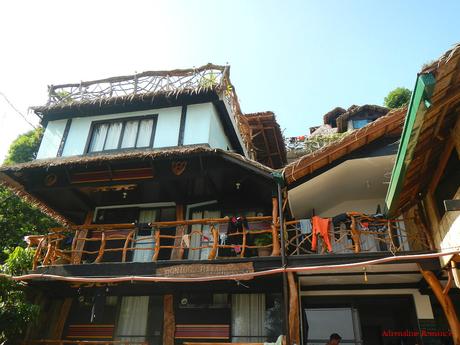
The top section of BBBB is a great place to hang out. It has a music and karaoke lounge, a game area, a bar, and a home resto. It’s not difficult to understand why divers would love to spend their non-diving hours here.
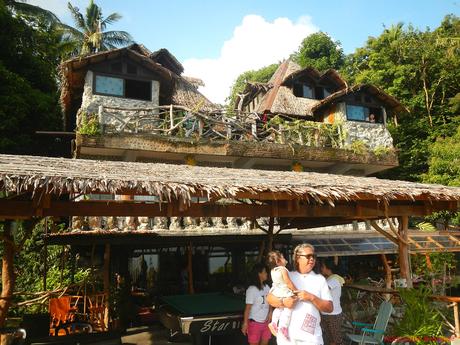
The decorations, furniture, and furnishings, which are mostly made of indigenous materials, are purely tribal and beautiful to look at. We could actually feel the passion and the love of the craftsmen who painstakingly made these items.
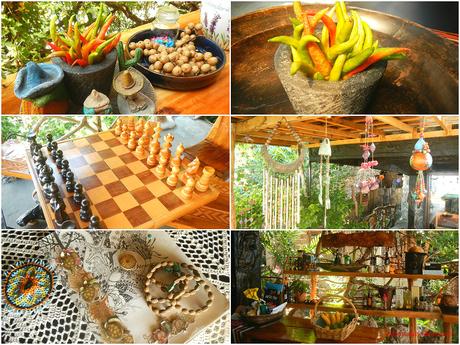
But for us, nature lovers, the best thing that BBBB offers is this encompassing view of Balayan Bay. Just imagine waking up each morning or relaxing for an afternoon tea to a view like this. Many spots around the bay are lovely dive sites.
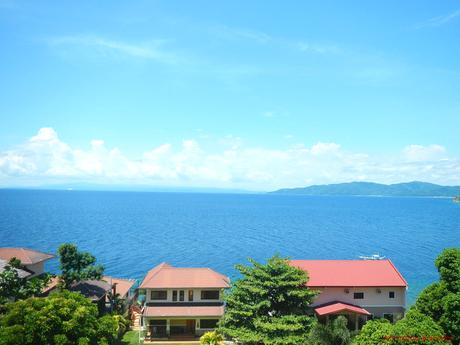
After registering and getting into our dive gear, we got into our open-air outrigger boat, which was just parked right across BBBB. When all our equipment and guides were on board, the engine muttered to life and we were on our way to our first dive site.
Along the way, one of our guides Jorge briefed Lorraine and May about scuba diving since both do not have diver’s licenses yet.
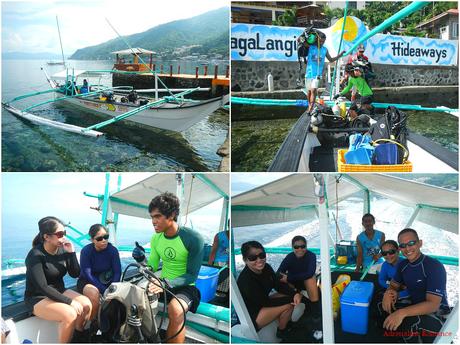
We cruised along Anilao’s coast towards Twin Rock, our first dive site. The coast is lined by all types of hotels and resorts that are bordered by still verdant forests and mountains. Check out the mirror-like aquamarine water.
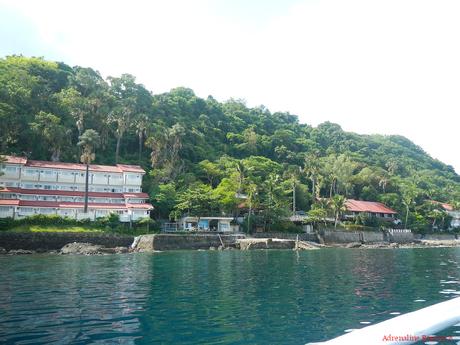
Twin Rocks
When we first entered the water, all we could see was vast areas of sand and rock. But as we moved forward, corals, fish, and other marine organisms became more plentiful. Here are large elephant ear corals near the entry point of the Twin Rock dive site.
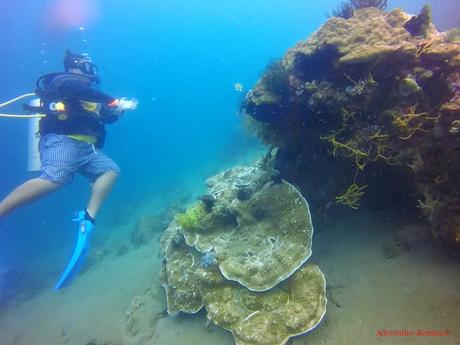
The farther we went, the more the corals became vibrant. Bare rocks and sandy patches gave way to sea anemones that seem to carpet every nook and cranny. Soft and hard corals abound, which formed an underwater forest.
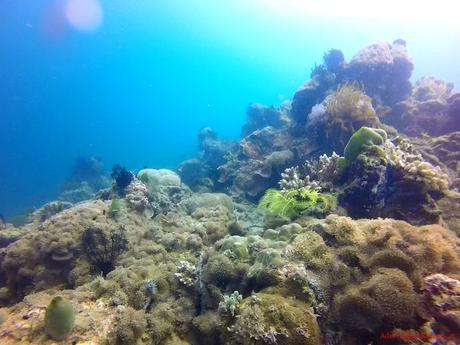
Let’s check out some of the interesting things we found in this dive site. We came across a couple of giant clams. Yes, that one is bigger than our computer table! With its mantle gently pulsating, it looks like it is ready to chop our limbs off should we make a foolish move of putting our hands near that soft, gray matter.
But in truth, the so-called danger that giant clams are known for is misrepresented. While it has a strong grip, the mollusc’s closing action is only defensive. Large specimens cannot close their shells completely due to the thick mantle.
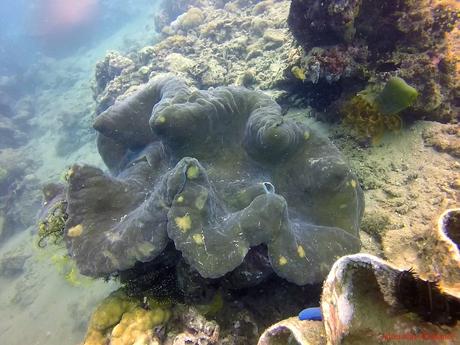
This little coral looks like a ball with octoid suckers. What in the world is this? Can someone identify this?

We saw these puffball things. What are these? They look like large jellybeans. If anyone reading this knows what this is, please tell us so we can update this description. Indeed, the beautiful and dangerous world beneath the sea is still hugely undiscovered.
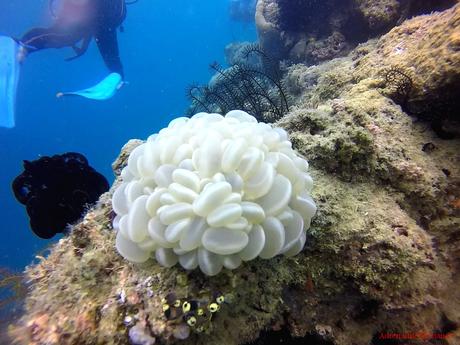
Along the way, we passed by this huge and dark structure. According to our Divemaster, this was actually a capsized barge that was purposely sunk to form an artificial reef. The endeavor was successful, and the barge’s hull is now encrusted with corals, barnacles, anemones, and other organisms.
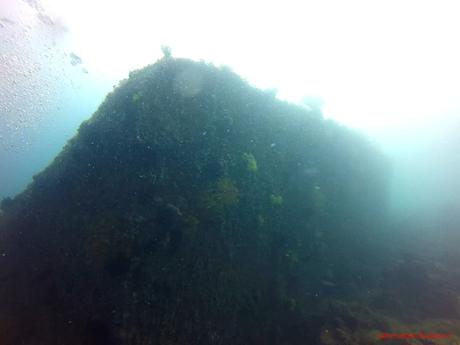
All around us are colorful crinoids, or feather stars. These are actually some sort of marine animals. The spiny tentacles are actually their arms, which surround a feeding mouth. The arms filter microorganisms and plankton from seawater.
Fossilized stems of crinoids are sometimes collected then threaded to form necklaces and bracelets.
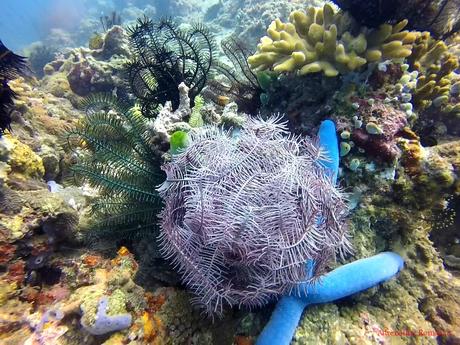
Here’s a snaky yellow coral surrounded by black crinoids. They live harmoniously, don’t they? Why can’t we, humans, do the same?
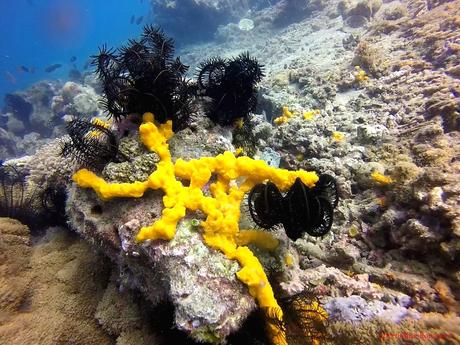
At first glance, we thought it was a discarded banana peel that got stuck in a brain coral. But closer inspection revealed that it was some sort of a calcareous sponge. Note the small light green globules as well. What are these?
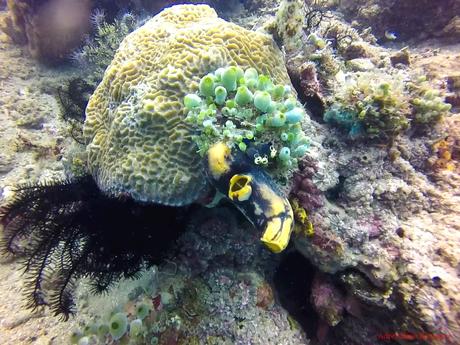
Now that’s a huge sea anemone with its mesentery fully exposed. The tentacles are venomous and are used to paralyze prey that comes too close to the anemone. Clownfish and similar species of fish are, however, immune to the powerful stings.
The two organisms form a mutually beneficial relationship; they protect each other from potential predators. It seems they understand a very simple principle; in a hostile environment, it pays to have true friends.
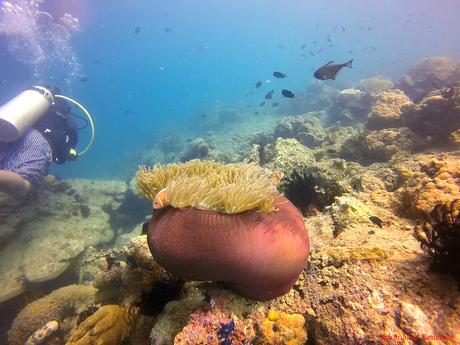
You’ve seen a lot of these small anemones during our previous dives. Their tentacles move and quiver, giving the illusion that they are glittering. The sea truly has an indescribable beauty that demands utmost respect.
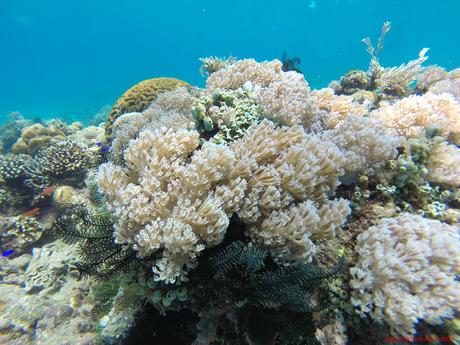
A group of spindly crinoids and rich corals acts as a community for hundreds of resident fish. Corals, marine plants, sponges, and other organisms play an important role in preserving this delicate ecosystem.
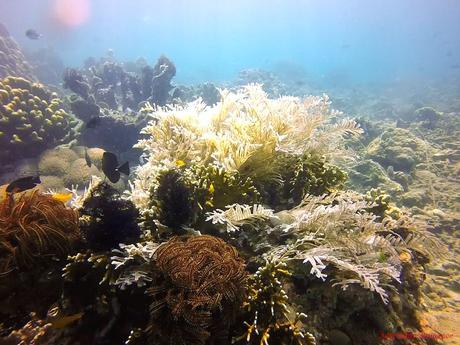
After an exhilarating dive, we went ashore to rest for an hour to allow the nitrogen in our bloodstream to dissolve. While doing so, we sat down in the shade to admire the view of Balayan Bay.
With large, smooth rocks instead of fine white sand, the shorelines of Anilao are not really magnets for beach lovers. However, visitors can rent outrigger boats to take them to neighboring islands and coves where one can find sandy beaches.

After an hour, we boarded our pump boat and headed towards Cathedral, our second dive site.
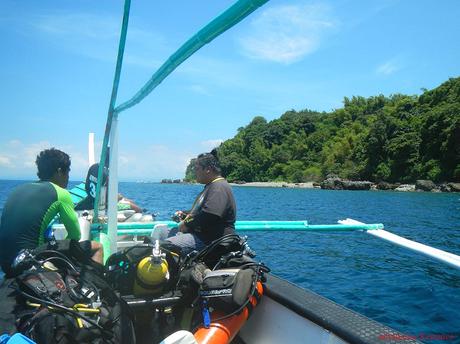
As we approached the jump-off of Cathedral, we saw a glimpse of Mt. Gulugod Baboy, one of the easiest mountains to climb in the region. According to our research, the summit offers a spectacular view of Anilao, Balayan Bay, and the surrounding areas. We would definitely climb this mountain on our next visit.
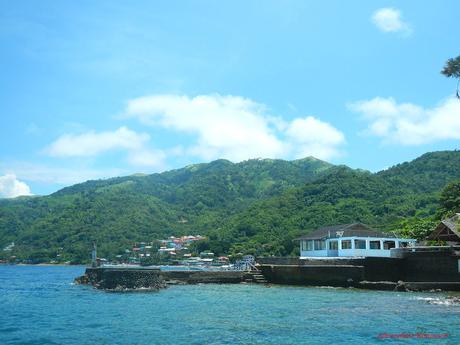
Cathedral
The moment we entered the water, we hovered on an immense field of corals and anemones. We were above an extraordinary biological underwater city!
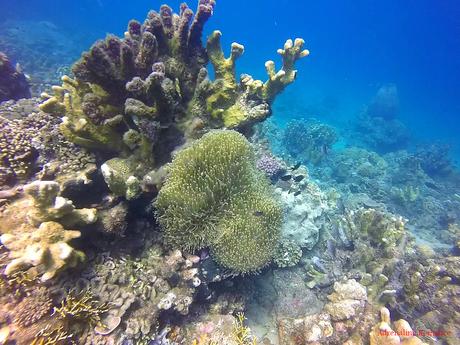
As we moved deeper, the coral fields made way to a sandy seabed. But that doesn’t mean the deep landscape is featureless. Indeed, there are so many interesting things which caught our attention like this massive jar-like coral. It’s actually as tall as me!
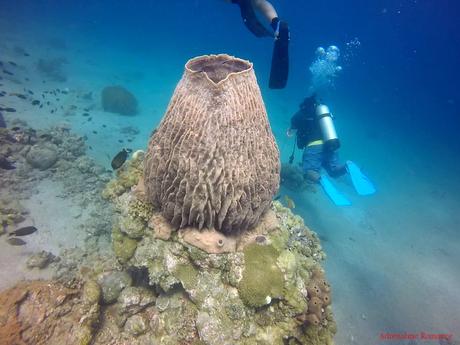
At 50 feet, we found more of these large jar-like corals amidst a vast sandy bottom. These corals make great hiding places for fish. In fact, when I passed on one of them, I could see a group of cleaner wrasses relaxing in the cavity.
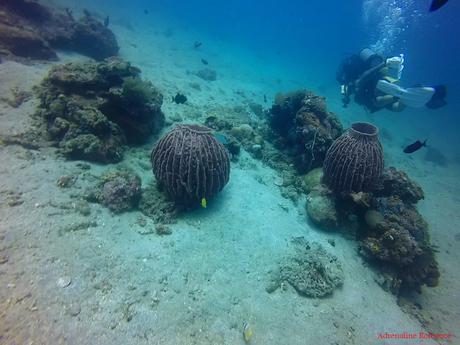
Spiny crinoids, colorful barnacles, globular sponges, vibrant fish—the sea is truly full of life. Check out that rare black coral.
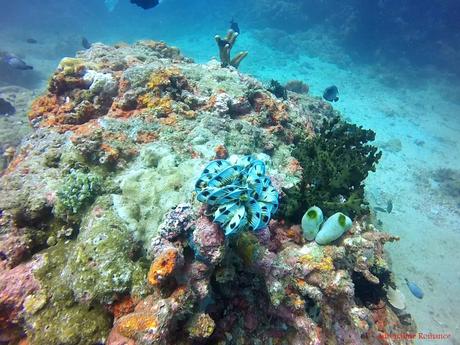
Then we saw this dark—something. Divemaster Jorge and Lay were already there ahead of us, and they seemed quite, well, busy and happy.
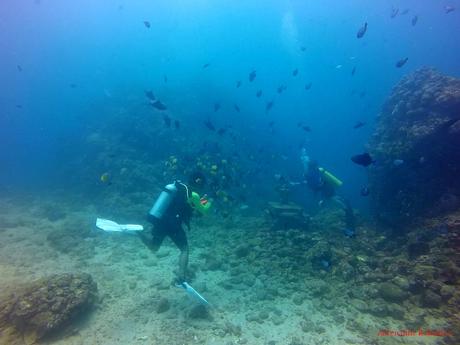
Well, it turned out we arrived at the heart of the dive site. The site is called Cathedral due to this small coral-encrusted cross, which was erected between two humongous rocks that guard the gateway to a deep abyss. According to our Divemasters, the cross was brought and sunk here by former Philippine President Fidel Ramos. Mr. Ramos, by the way, is an avid traveler.
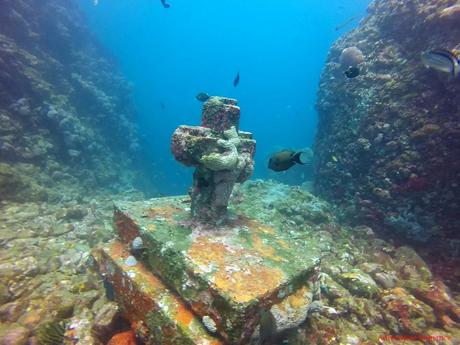
It seems that there’s something in the Cathedral that is charming to fish. In fact, when we arrived there, we were caught in a tornado of fish! There must have been thousands as we could not even see in front of us except fins, scales, and tails!

A little farther up from the Cathedral’s cross, we found a nice barnacle-encrusted play castle. This is a nice playground for kiddie fish that have plenty of imagination. Hehehe!
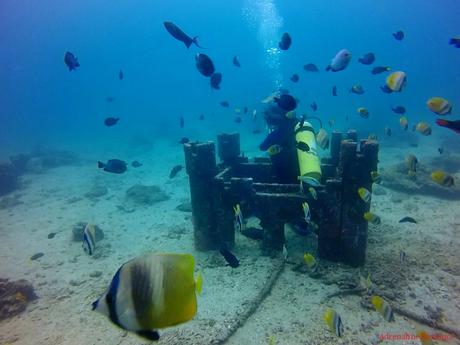
These are creepy-looking tree corals! We’re not really sure if we’re right, but these may be members of the Capnella. Their branches produce toxins to stun fish and other organisms. The toxins, however, do not pose any danger to humans.
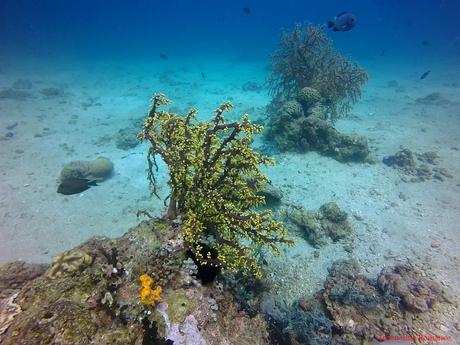
We are addicted to the beauty of the underwater world. Just check out the huge amount of diversity in this small patch of coral reef. You can find more living things in 5 seconds under the sea than in 5 hours in the mountain.
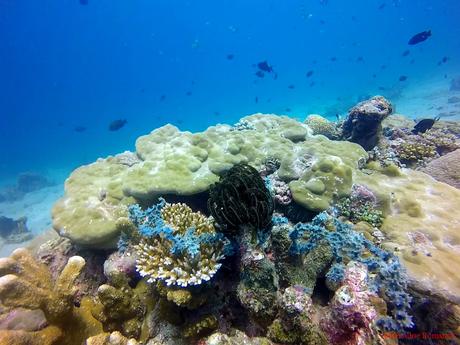
Come out and play, Nemo! The rich dive sites in Anilao have plenty of large sea anemones like this.
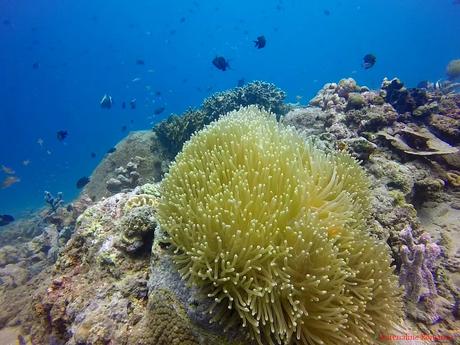
As we slowly rose towards shallow water, we came across large fields of hard corals. Many of them are damaged and destroyed due to a combined onslaught of overdiving and natural forces. When we got back on land, Divemaster Jorge told us that vast sections of coral reefs were wiped out during recent storms.

Don’t be deceived by our photos that seemingly imply that coral reefs are sanctuaries of tranquility. For resident organisms, reefs are, in fact, dangerous places. Within the nooks and crevices await viscous predatory creatures that mercilessly prey upon many of the reef’s residents.
Take for example this regal lionfish. While it may look beautiful, it is a dangerous creature. Those spiky fin rays are venomous. Lionfish use their venom to stun other fish or to protect themselves from predators.
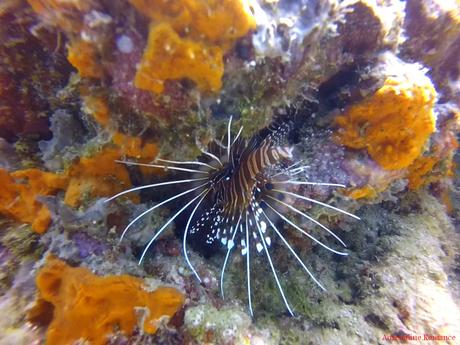
Here’s another dangerous creature. Can you see it? It’s right at the center of the photo. Yes, the one that looks like a rock.
That is a well-camouflaged scorpionfish and is considered to be one of the most venomous marine creatures in the world. Those needle-sharp spines emit a very potent venom, which, if left unchecked, can cause an immense amount of pain and even death. The spines are so sharp that they can pierce through soft soles. Their exceptional camouflage makes them even more dangerous; fish and people mistake them as moss-covered rocks.
This is why when snorkeling or diving, you should avoid stepping on corals, rocks, or even the seabed itself. The sea has a lot of unknowns, and not respecting the presence of those unknowns can be very detrimental.
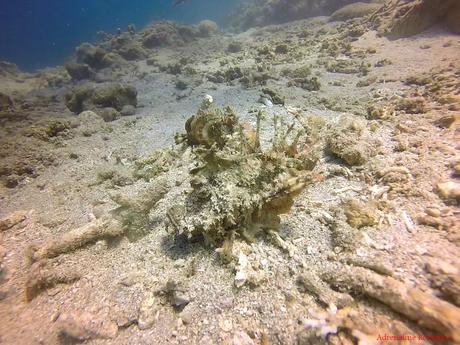
Our dive ended with a very pleasant cap. As we moved to shallow water, we found this large and gorgeous hawksbill turtle pass right by us. It is easily distinguished from other turtles by its sharp, curving beak and saw-like shell edges.

As usual, we document our dives via video. Mere pictures just can’t capture enough of the magic and the wonder of the alien world beneath us.
The funny thing about our dive is that after we emerged on the shore, we realized the surroundings were all too familiar. Well, it’s because we surfaced right at the pier in front of BBBB! Navigating underwater is definitely a challenge; we didn’t realize we were near our starting point!
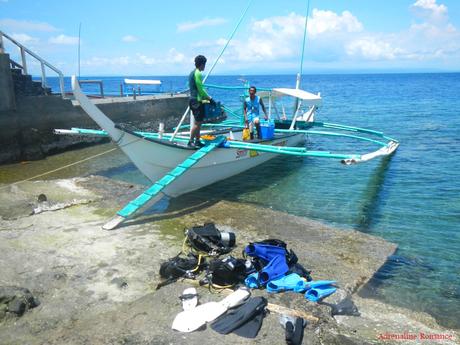
After showering and changing to dry clothes, we were treated to a sumptuous lunch of delicious grilled prawns, crunchy veggies, and chunky bean soup. Chocolate ice cream garnished with sugar pearls and drizzled with chocolate syrup capped our heavy meal.
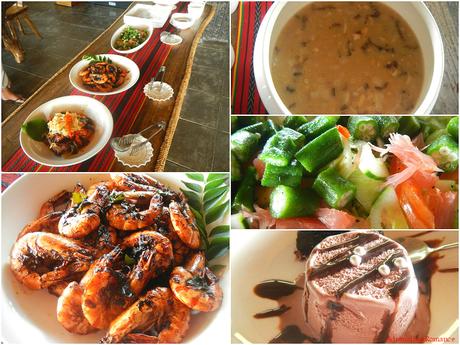
After saying our thanks to our gracious service provider, we went back to our scenic home in Kapusod Tree House. We arrived just in time to witness another beautiful sunset. The shadow looked like a highway in the sky! Sunsets like these fill our soul with peace and childlike wonder.
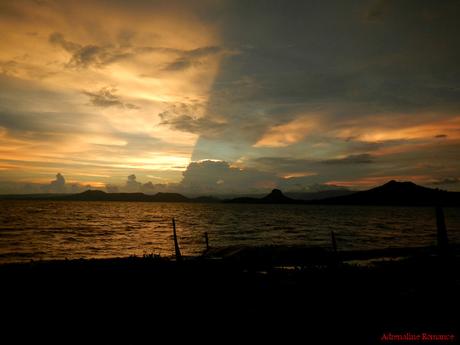
The last good news of the day was in the form of a change of rooms. Instead of a cabana, our host led us to the now-vacated treehouse. Just imagine; we’re going to spend the night on top of a tree! How amazing is that!
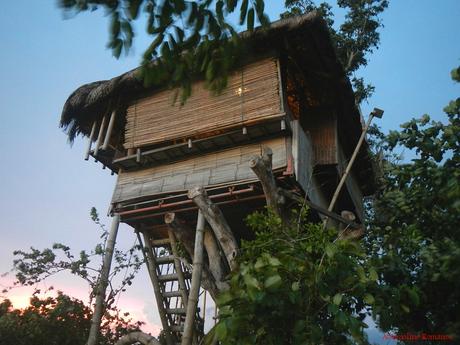
Overall, our diving trip to Anilao was a very enjoyable and exhilarating experience. Once again, we rediscovered the enchanting dive sites and enchanting reefs that make our country one of the best diving destinations in the world. As Filipinos, we are truly blessed to have such natural treasures. How magnificent they will stay depends on us as custodians of this mysterious world that is so near to us.
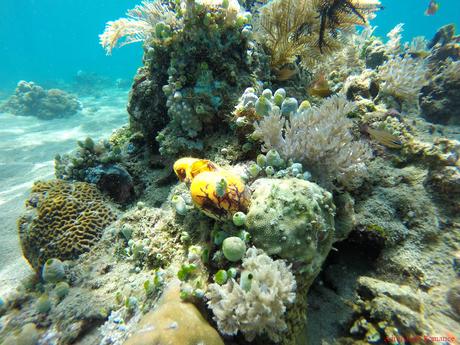
Tips to follow

